- Home
- Lisa Smedman
Blood Sport Page 16
Blood Sport Read online
Page 16
“Thank you,” I said. “But there is one thing we could use help with. Getting out again. When it comes time to leave, we’ll need to get out of Aztlan quickly and quietly, and for that we’ll need the help of the AFL. I don’t want to use our original contact—we think he may have been . . . compromised. Is there some other way to get in touch with the Freedom League?”
Kukulcán nodded at the troll. “We monitor a number of different message boards. When the time comes, leave a message with your location, and we will make sure it is forwarded. My assistant will handle it personally.”
He gave me an LTG address, made both Rafael and I repeat it to be sure we had memorized it properly, then nodded.
“Now I must ask that you leave,” he said. “I have—business—that I need to attend to. Águila can take you back to the main road, and from there can brief you on the roadblocks and government patrols that lie between here and Izamal. That should make the rest of your journey easier. It will help your fate to unfold as it should.”
His smile looked genuine—warm almost. “I wish you well. I would love to see you strike a blow for freedom.”
“Thanks,” I told the feathered serpent. Its support was starting to make sense. The enemy of my enemy—and all that drek. Whatever steps we took to bring Mama G’s murderer to justice, we’d be a thorn in the side of the Azzie government. And that could only be good for the rebel cause.
The fact that Kukulcán—or Soñador, as he also called himself—had let us see his human form made me feel much better. The feathered serpent obviously was confident enough in our abilities to think that we could avoid capture by the Azzies. Or maybe it just didn’t matter. Maybe Soñador had a dozen different names and faces.
But what was that comment about our “fate?” I was a firm believer in free will—I didn’t even call up my horoscope in the morning tridcast. The Azzies, though, seemed to be big on fate and prophecies.
By the time this was over, I’d change my opinion. For the moment, however, I remained blissfully optimistic—and unaware of what the future would hold.
14
If I’d thought that Aztechnology Security Corporation maintained a heavy presence in Tenochtitlán, compared to Izamal, they’d been discreet.
Izamal is a town of about fifteen thousand people—it used to be larger, but the VITAS epidemic had hit it pretty hard, and it never really recovered. It’s smack in the middle of the Yucatán and used to be dependent upon the tourist trade before the rebellion heated up. Now the streets are filled with soldiers, patrolling in jeeps, standing guard outside key buildings, watching everyone who goes by.
We reached Izamal about three hours after our meeting with Soñador, and it was already getting dark. The motorcycle was loud—its muffler was strictly decorative after the confrontation at the checkpoint. Exhaust poured through the bullet holes in it, making it roar like a tank. Soldiers gave us surly looks as we roared past, and I prayed that they wouldn’t stop us, just out of spite.
Several of the buildings in Izamal bore telltale pockmarks where bullets had struck their pastel-painted walls. Citizens scurried along the sidewalks, heads down to avoid making eye contact with the patrolling soldiers. In one jeep we passed, a cage in the back held a bird as big as a human, with a nasty-looking beak and lashing tail. I’d never seen a cockatrice before—it looked like an oversized rooster. Magically active, the bird could paralyze with a flick of its tail. I should have guessed that the Azzie troops would be making use of Awakened beings.
We were looking for a hotel or posada—somewhere to spend the night. But everyone seemed to be closing up shop. Merchants rolled down and padlocked the corrugated metal doors that fronted their stores, apartment block residents swung heavy wooden doors shut, and windows were being shuttered against the night. Hotels were few and far between, and those we did pass had “Closed” signs hanging in their windows.
As the gloom deepened, a helicopter gunship flew low overhead. A speaker mounted on the belly of it blared a warning down to the streets below. “Atención! Atención! Curfew will be in effect in fifteen minutes. Clear the street, por favor. Please clear the streets.”
I tapped Rafael on the shoulder and shouted in his ear. “We’re fragged if we don’t find somewhere to doss down soon.”
He let the motorcycle glide to a halt at an intersection. The building beside us had been painted a pastel pink with green trim around the doors. Graffiti splashed across it in red paint showed through a patch of whitewash that had been unsuccessful in covering it up. “Cristeros!” it proclaimed. I wondered who Christ’s warriors might be.
“Do you want to try and get out of town?” he shouted back over the muffler roar.
“We’d never make it.” I glanced over at two soldiers who had pulled up beside us in their jeep. Both were well-armored, and the one in the passenger seat wore night-vision goggles and carried a lethal-looking assault rifle. I made the mistake of flashing him what I’d intended as a reassuring smile. It must have clued him to that fact that I wasn’t a local. He sat up straighter in his seat and began to turn the barrel of his rifle toward me . . .
Just at that moment Rafael gunned the motorcycle and sent us roaring around the corner, down a side street. It must have looked like an evasive move. As I clung tight to his waist, I glanced back and saw the jeep’s driver frantically turning the wheel to follow us.
“Blast us out of here, Raf!” I shouted. “We’ve got pursuit!”
Rafael leaned lower over the bike and gave it more gas. Shops and homes flashed past on either side as we picked up speed. We cut one corner tight, pegs scraping the ground and sending up sparks, and zoomed through a red light in an intersection that was empty of traffic. The curfew must have already gone into effect—the streets were bare.
I thought we’d lost the jeep, but then it shot out of a side street directly behind us. I heard the angry, muffled chuff-chuff-chuff of an assault rifle and saw a streak of red tracers lance past on the right. I clenched my teeth together and held on tight as the motorcycle took another sharp turn. Any second now, I would take a bullet in the back . . .
We roared into the plaza at the center of the town, circling around the edge of it to give a wide berth to the two tanks that squatted there like black metal bugs. I gulped when I saw them, but they seemed inactive at the moment. Or perhaps their drivers didn’t want to waste heavy ordnance on so small a target as us. Or maybe they just wanted to sit back and watch the chase.
The plaza was surrounded by Colonial-style buildings, each of them built on top of low mounds that were all that remained of the Mayan city on which the modem town had been built. On the far side of the plaza, a stone staircase that looked suspiciously like those on the temple pyramids led up to a wide courtyard flanked by curving arches.
“Hang on!” Rafael shouted.
I gasped as we hit the stairs. The bike bucked its way up them like an angry horse, leaving a plume of blue smoke in its wake and nearly shaking me off the back. But somehow I held on. I heard another burst of rifle fire, saw chips fly from the stone steps as we raced past. But we must have been moving too erratically to make an easy target. After what seemed an eternity, we reached the top of the stairs and soared into the air. We seemed to float for one heartbeat, two . . . and then the motorcycle slammed down into the courtyard, rear tire smoking as it fought for a grip on the flagstones.
The rifle fire stopped. The angle of the steps must have cut us off from the soldiers’ line of sight. But I knew it wouldn’t be long before they radioed for backup.
At the far end of the courtyard stood the looming bulk of the sixteenth-century church that had dominated this town’s skyline for centuries. A rusted and bullet-scarred sign we passed identified it as the Santuario de la Virgen de Izamal. This must be the church where the feathered serpent Soñador had said we could contact the priest who’d helped Mama Grande. Sanctuary of the Virgin—the most likely spot to find an alcove of the Virgin. Besides, it was the only church in t
own that was still standing.
As we circled around to the rear of the church, I could see that its windows had been boarded and its main doors padlocked shut. The statues of saints that had once filled niches in the outer walls had been defaced by having their heads knocked off, and the bell tower had collapsed. Garbage lay in heaps in what had once been a surrounding garden. But even so, the building was an impressive one, with plenty of columns, domes, and arches. I could imagine its glory in former decades.
“Raf!” I shouted. “We’re sitting ducks on this bike. Every soldier in town will be looking for it now. Let’s hole up in the church. Perhaps the priest will find us before the soldiers do.”
Rafael cut the engine of the motorcycle and let it roll silently down one of the weed-choked walkways that led to the church itself. It was almost dark now, and searchlights from the helicopters that circled overhead stabbed down into the town below as the Azzies searched for curfew violators.
We hid the motorcycle in an alcove that sheltered one of the church’s side doors—padlocked like the rest and hung with a No hay paso sign. From there we crept around to the back of the church, looking for an access point. We found a place where some lumber that looked like smashed pews had been piled in a heap against a wall, underneath a window. The plastiboard that had been nailed over the window was loose and swung back easily.
Rafael gave me a boost and I climbed in through the middle of what had once been a stained glass depiction of Christ on the cross. The center of the window was little more than twisted strands of lead, but the edges of the window were still intact—on either side of me was a nail-pierced, bloody hand.
Rafael clambered in behind me and eased the plastiboard that covered the window back into place. The interior of the church was utterly dark, but I had the sense of cavernous space. I heard the flick of Rafael’s lighter, and then a pool of warm yellow light surrounded us.
“What now?” Rafael asked. His low voice echoed against the high ceilings and stone walls.
I looked around at the jumbled, dust-covered mess that filled the church. The altar had been smashed and lay in pieces, the few pews that remained had been shoved into a heap against one wall, and the carpets that covered the central aisle were filthy and mold-spotted. Murals on the walls and ceilings had been crudely painted over with black paint and the carved wooden statues of saints that had once stood in alcoves had been tossed to the floor and burned where they lay. A sour, damp-charcoal smell hung in the air.
I spotted a confessional booth near the front of the church. An alcove, larger than the others, was set into the wall nearby. In it stood a shadow-shrouded statue. A wrought iron rack for votive candles stood in front of the alcove, but the red glass cups that once held the candles lay on the floor beneath it, broken. The shards glittered with the same hue as freshly spilled blood in the flickering illumination of the lighter. I hoped that wasn’t an omen.
“There’s the confessional, and the alcove where we’re to light a candle,” I said in a whisper. Somehow, it didn’t seem appropriate to talk out loud. “Let’s check it out.” I cringed as a helicopter roared past overhead, and only relaxed when its engines had faded into the distance.
We crossed to the alcove for a closer look. It held a wooden statue of a female figure in a blue robe trimmed with gold, cradling an infant in her arms. The faces of both woman and child had been hacked off—only the crisscrossed scars of deep axe cuts remained. And someone had been at her robe with a knife in an effort to scrape off its gilt trim. From the dents and scuffs on the body of the statue, I guessed that it had been tumbled from its base. But someone had lifted it back into place again. Next to the alcove, a marble plaque on the wall commemorated the visit of Pope John Paul II during the Festival of the Virgin in August of 1993.
“Looks like Mary’s had a tough time of it,” Rafael said.
I nodded. I knew that Catholicism had been banned in Aztlan since 2041, but the mutilated statue of the Virgin Mary brought it home to me. I’d never been one for religion—my mother had to literally drag me to church when I was a kid and then threaten to take my toy laser gun and plastic cop badge to make me behave once I was there. After my parents separated, my father stopped going to Mass, and I happily returned to playing cops and runners games on Sundays. But I had fond memories of the serene face of a similar Virgin Mary—although in my parents’ church, she had been a holo. Mary had always seemed so much more approachable than the stern saints and so much less frightening than the mutilated bodies of the martyrs or the tortured corpse of Christ on the cross.
Programmed by my early upbringing, I started to raise a hand to cross myself. Then I stopped. Religion was just so much bulldrek—window dressing in this modem age. If you wanted a miracle, magic and technology were the answers—not prayers to some non-existent saint or god.
Rafael reached into the pocket of his jacket and pulled out one of the candles we’d purchased at a tienda on the way into town. With Catholicism banned in Aztlan, we figured we’d have to bring our own votive candles to the church. I just hoped the Virgin wouldn’t take offense at a birthday candle shaped like the number one. Rafael picked up the most intact glass cup from the floor and melted the base of the candle onto it. Then he set the candle on the wrought-iron frame in front of the statue and lit it. “Might as well,” he said. “Maybe we’ll luck out and the priest will come by tonight.”
“Or maybe the Azzie soldiers will find us first,” I reminded him. But there was little else we could do. Venturing out into the streets right now would be suicide.
“If you find a hiding place that will give me covering fire, I’ll take the first shift in the confessional,” I suggested.
Rafael nodded his agreement. While he hid himself among the benches that had once housed the choir at the front of the church, I turned to the confessional and opened its wooden door. It was an old-fashioned style confessional, one in which both penitent and priest had to enter in person—unlike the virtual linkups found in modem churches. The carvings on the outside of the confessional were gouged and the door hung from one hinge, but the seat inside and latticework that separated priest from penitent were still intact. I sat down on the seat, hoping that the closet-like structure wasn’t about to become my coffin. And waited. And listened. And despite my jittery nerves, eventually dozed ...
I sat bolt upright as I heard the click of a door closing. I plunged a hand into my jacket and hauled out the Savalette Guardian I’d taken from the dead elf at the checkpoint. Its high-powered slugs would easily punch through the wood that separated the two sides of the confessional. I flicked its safety, raised it. . .
That’s when I came to my senses. If the Azzie soldiers had found me, I’d be dead already. I realized that it must be the priest who sat behind the screen. I decided to go through the routine, so as not to scare him off.
“Bless me, Father, for I have sinned. It has been ...” I had to think for a moment. “It has been sixteen years since my last confession.”
“What are your sins, my child?” a soft male voice asked.
I took a deep breath. Where to start? If the Catholic god did exist, he’d need gigapulses of memory to upload everything I had to say. Since my last confession I must have committed dozens of mortal sins and hundreds of venial sins. I hadn’t attended Mass or taken Communion since I was thirteen. Not to mention that I’d gone through a period of trying out different churches in my early twenties—of worshipping “strange gods before thee.”
And yet, I didn’t figure that any of that really mattered. I considered myself one of the “good guys.” I’d been a crusader for justice when I was with Lone Star, and in my private detective work I only took on cases when I honestly believed that the client was in the right. It meant passing up nuyen from time to time—I certainly could have made much more as a shadowrunner working clandestinely for the corps—but it left me with a clean conscience.
But there was one thing I’d done wrong. One big thing. “I ...
I failed to prevent the death of my abuelita." I began. “She was murdered. And I could have prevented it.”
“How could you have done that?” the soft voice asked.
“I could have realized how much danger she was in. I could have arranged for additional protection for her. I could have—”
“I’m sure you did everything you could.”
I sighed. Logically, I knew I’d made all the right moves. But a little voice inside gnawed at me. If I’d only done this. If I’d only realized that. . .
“Is there anything else you’d like to confess?”
“No.”
“Even after sixteen years?” The voice sounded slightly bemused.
“Father Gustavo Silvio?” I asked.
There was a pause, as if I’d surprised him by knowing his name. Then, “Yes?”
“I’m a friend of Rosalita Ramirez. Can I speak with you outside the confessional?”
The pause was longer this time. “Very well.”
I put the pistol away and stepped out of the big wooden box—only to see Rafael pop up from his hiding place near the altar and aim his Streetline Special as the middle door of the confessional also opened.
“Leni!” he shouted. “Behind you!”
I threw up my hands. “Don’t shoot, Raf!” I called back. “It’s the priest.”
“Where the frag did he come from?” His voice still sounded edgy and tired, but he lowered his pistol. I decided that Rafael must have dozed off, just as I did. We’d both been exhausted.
Father Gustavo Silvio stood beside me, looking back and forth between Rafael and I. He looked young, perhaps in his mid-twenties. That would have put him at maybe ten years old when Catholicism was banned in Aztlan—too young to have been ordained by anything but an underground practitioner of the faith. He wore lay clothes—naturally enough, since he couldn’t wear a priest’s vestments—and was strikingly handsome—good-looking enough to make me wonder if Catholic priests still practiced celibacy. He had the lean body of an athlete, dark hair that swept back from his face in a series of curls, and eyes that were intense and somehow sorrowful at the same time.

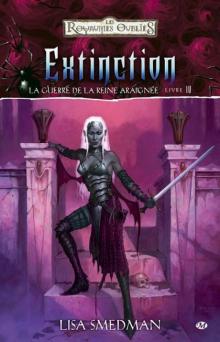 Extinction
Extinction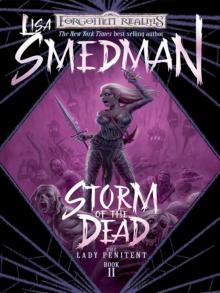 Storm of the Dead
Storm of the Dead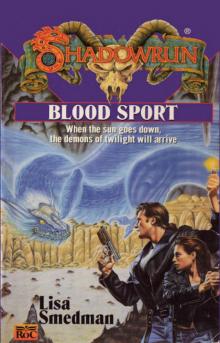 Blood Sport
Blood Sport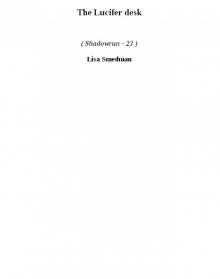 The Lucifer desk (s-2)
The Lucifer desk (s-2) Vanity's Brood
Vanity's Brood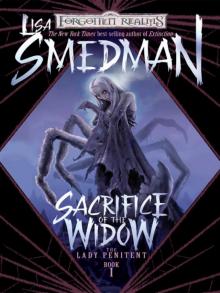 Sacrifice of the Widow
Sacrifice of the Widow Vanity's brood hos-3
Vanity's brood hos-3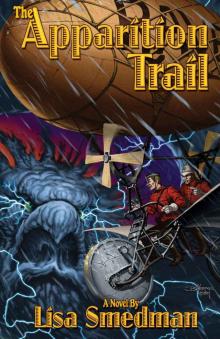 Apparition Trail, The
Apparition Trail, The Venom's Taste
Venom's Taste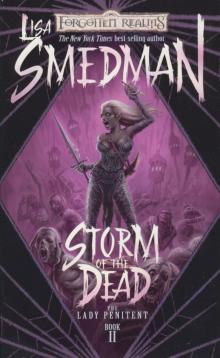 Forgotten Realms - The Lady Penitent - Storm of the Dead
Forgotten Realms - The Lady Penitent - Storm of the Dead Viper's kiss hos-2
Viper's kiss hos-2 Tails You Lose
Tails You Lose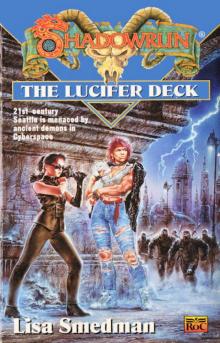 The Lucifer Deck
The Lucifer Deck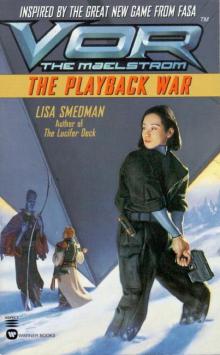 Vor: The Playback War
Vor: The Playback War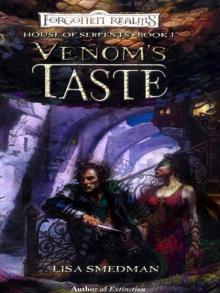 Forgotten Realms - House of Serpents 1 - Venom's Taste
Forgotten Realms - House of Serpents 1 - Venom's Taste Storm of the Dead зкp-2
Storm of the Dead зкp-2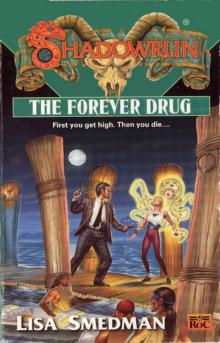 The Forever Drug
The Forever Drug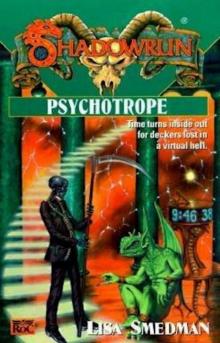 Psychotrope
Psychotrope Realms of Shadow a-8
Realms of Shadow a-8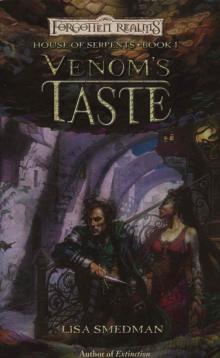 Venom’s Taste hos-1
Venom’s Taste hos-1 Psychotrope s-33
Psychotrope s-33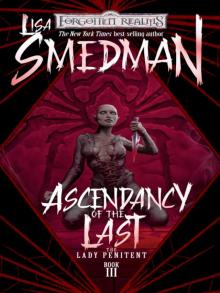 Ascendency of the Last
Ascendency of the Last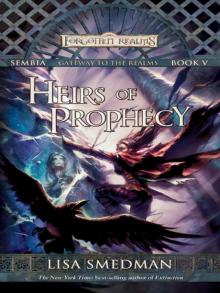 Heirs of Prophecy
Heirs of Prophecy Ascendancy of the Last зкp-3
Ascendancy of the Last зкp-3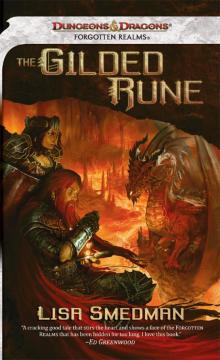 The Gilded Rune (forgotten realms)
The Gilded Rune (forgotten realms)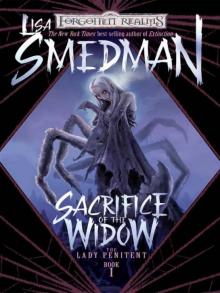 Sacrifice of the Widow: Lady Penitent, Book I
Sacrifice of the Widow: Lady Penitent, Book I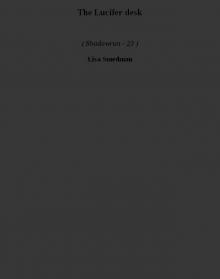 The Lucifer desk s-23
The Lucifer desk s-23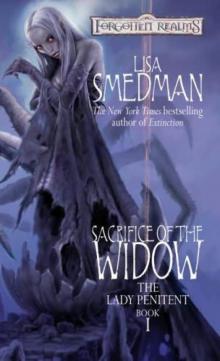 Sacrifice of the Widow lp-1
Sacrifice of the Widow lp-1 Viper's Kiss
Viper's Kiss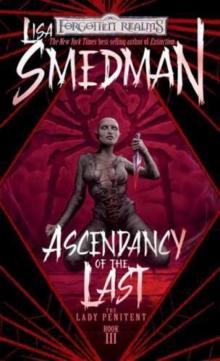 Forgotten Realms - The Lady Penitent - Ascendancy of the Last
Forgotten Realms - The Lady Penitent - Ascendancy of the Last